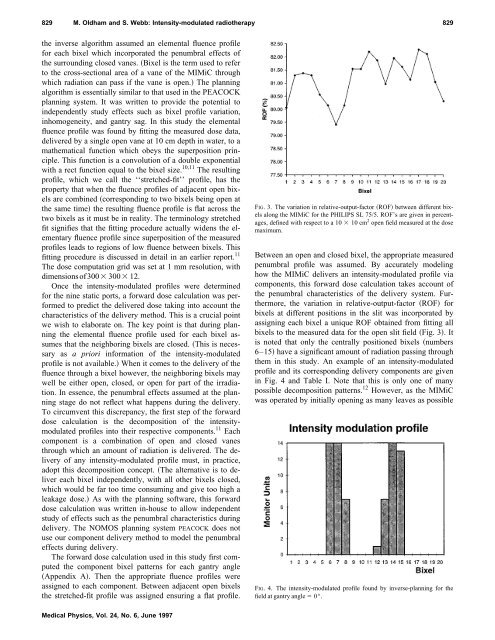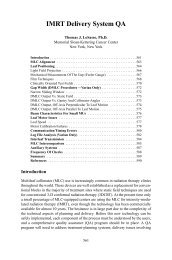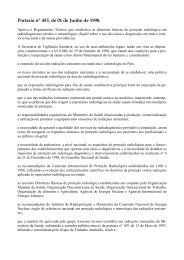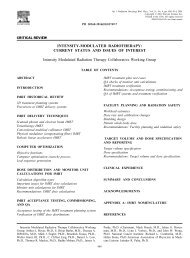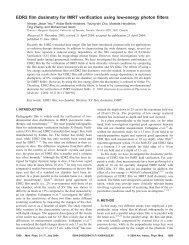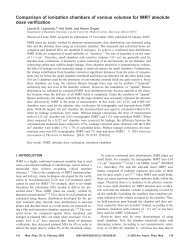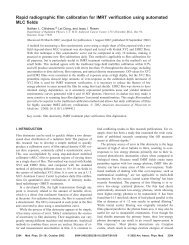Intensity-modulated radiotherapy by means of static tomotherapy: A ...
Intensity-modulated radiotherapy by means of static tomotherapy: A ...
Intensity-modulated radiotherapy by means of static tomotherapy: A ...
Create successful ePaper yourself
Turn your PDF publications into a flip-book with our unique Google optimized e-Paper software.
829 M. Oldham and S. Webb: <strong>Intensity</strong>-<strong>modulated</strong> <strong>radiotherapy</strong> 829<br />
the inverse algorithm assumed an elemental fluence pr<strong>of</strong>ile<br />
for each bixel which incorporated the penumbral effects <strong>of</strong><br />
the surrounding closed vanes. Bixel is the term used to refer<br />
to the cross-sectional area <strong>of</strong> a vane <strong>of</strong> the MIMiC through<br />
which radiation can pass if the vane is open. The planning<br />
algorithm is essentially similar to that used in the PEACOCK<br />
planning system. It was written to provide the potential to<br />
independently study effects such as bixel pr<strong>of</strong>ile variation,<br />
inhomogeneity, and gantry sag. In this study the elemental<br />
fluence pr<strong>of</strong>ile was found <strong>by</strong> fitting the measured dose data,<br />
delivered <strong>by</strong> a single open vane at 10 cm depth in water, to a<br />
mathematical function which obeys the superposition principle.<br />
This function is a convolution <strong>of</strong> a double exponential<br />
with a rect function equal to the bixel size. 10,11 The resulting<br />
pr<strong>of</strong>ile, which we call the ‘‘stretched-fit’’ pr<strong>of</strong>ile, has the<br />
property that when the fluence pr<strong>of</strong>iles <strong>of</strong> adjacent open bixels<br />
are combined corresponding to two bixels being open at<br />
the same time the resulting fluence pr<strong>of</strong>ile is flat across the<br />
two bixels as it must be in reality. The terminology stretched<br />
fit signifies that the fitting procedure actually widens the elementary<br />
fluence pr<strong>of</strong>ile since superposition <strong>of</strong> the measured<br />
pr<strong>of</strong>iles leads to regions <strong>of</strong> low fluence between bixels. This<br />
fitting procedure is discussed in detail in an earlier report. 11<br />
The dose computation grid was set at 1 mm resolution, with<br />
dimensions<strong>of</strong>300 300 12.<br />
Once the intensity-<strong>modulated</strong> pr<strong>of</strong>iles were determined<br />
for the nine <strong>static</strong> ports, a forward dose calculation was performed<br />
to predict the delivered dose taking into account the<br />
characteristics <strong>of</strong> the delivery method. This is a crucial point<br />
we wish to elaborate on. The key point is that during planning<br />
the elemental fluence pr<strong>of</strong>ile used for each bixel assumes<br />
that the neighboring bixels are closed. This is necessary<br />
as a priori information <strong>of</strong> the intensity-<strong>modulated</strong><br />
pr<strong>of</strong>ile is not available. When it comes to the delivery <strong>of</strong> the<br />
fluence through a bixel however, the neighboring bixels may<br />
well be either open, closed, or open for part <strong>of</strong> the irradiation.<br />
In essence, the penumbral effects assumed at the planning<br />
stage do not reflect what happens during the delivery.<br />
To circumvent this discrepancy, the first step <strong>of</strong> the forward<br />
dose calculation is the decomposition <strong>of</strong> the intensity<strong>modulated</strong><br />
pr<strong>of</strong>iles into their respective components. 11 Each<br />
component is a combination <strong>of</strong> open and closed vanes<br />
through which an amount <strong>of</strong> radiation is delivered. The delivery<br />
<strong>of</strong> any intensity-<strong>modulated</strong> pr<strong>of</strong>ile must, in practice,<br />
adopt this decomposition concept. The alternative is to deliver<br />
each bixel independently, with all other bixels closed,<br />
which would be far too time consuming and give too high a<br />
leakage dose. As with the planning s<strong>of</strong>tware, this forward<br />
dose calculation was written in-house to allow independent<br />
study <strong>of</strong> effects such as the penumbral characteristics during<br />
delivery. The NOMOS planning system PEACOCK does not<br />
use our component delivery method to model the penumbral<br />
effects during delivery.<br />
The forward dose calculation used in this study first computed<br />
the component bixel patterns for each gantry angle<br />
Appendix A. Then the appropriate fluence pr<strong>of</strong>iles were<br />
assigned to each component. Between adjacent open bixels<br />
the stretched-fit pr<strong>of</strong>ile was assigned ensuring a flat pr<strong>of</strong>ile.<br />
FIG. 3. The variation in relative-output-factor ROF between different bixels<br />
along the MIMiC for the PHILIPS SL 75/5. ROF’s are given in percentages,<br />
defined with respect to a 10 10 cm 2 open field measured at the dose<br />
maximum.<br />
Between an open and closed bixel, the appropriate measured<br />
penumbral pr<strong>of</strong>ile was assumed. By accurately modeling<br />
how the MIMiC delivers an intensity-<strong>modulated</strong> pr<strong>of</strong>ile via<br />
components, this forward dose calculation takes account <strong>of</strong><br />
the penumbral characteristics <strong>of</strong> the delivery system. Furthermore,<br />
the variation in relative-output-factor ROF for<br />
bixels at different positions in the slit was incorporated <strong>by</strong><br />
assigning each bixel a unique ROF obtained from fitting all<br />
bixels to the measured data for the open slit field Fig. 3. It<br />
is noted that only the centrally positioned bixels numbers<br />
6–15 have a significant amount <strong>of</strong> radiation passing through<br />
them in this study. An example <strong>of</strong> an intensity-<strong>modulated</strong><br />
pr<strong>of</strong>ile and its corresponding delivery components are given<br />
in Fig. 4 and Table I. Note that this is only one <strong>of</strong> many<br />
possible decomposition patterns. 12 However, as the MIMiC<br />
was operated <strong>by</strong> initially opening as many leaves as possible<br />
FIG. 4. The intensity-<strong>modulated</strong> pr<strong>of</strong>ile found <strong>by</strong> inverse-planning for the<br />
field at gantry angle 0°.<br />
Medical Physics, Vol. 24, No. 6, June 1997


